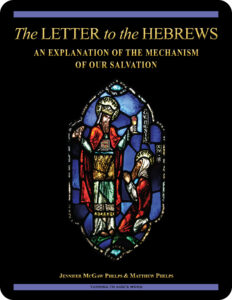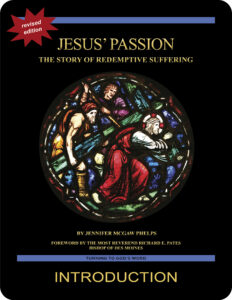 The Letter to the Hebrews:
The Letter to the Hebrews:
An Explanation of the Mechanism
of Our Salvation
Lesson 15 Abuse Suffered for the Christ
the Letter to the Hebrews 11:23–31
Revised Standard Version Catholic Edition (RSVCE)*
New American Bible Revised Edition (NABRE)*
Catechism of the Catholic Church
ex libris (in our library)
Tami Palladino’s visual-meditation journal
cross references in the Letter to the Hebrews
next lesson: God Had Foreseen Something Better
This material coordinates with Lesson 15 on pages 53–55 in The Letter to the Hebrews: An Explanation of the Mechanism of Our Salvation.
“In the days of his flesh, Jesus offered up prayers and supplications with loud cries and tears, to him who was able to save him from death, and he was heard for his godly fear. Although he was a Son, he learned obedience through what he suffered; and being made perfect he became the source of eternal salvation to all who obey him, being designated by God a high priest according to the order of Melchizedek.”—the Letter to the Hebrews 5:7–10
welcome to our in-depth study of the Letter to the Hebrews
We invite you to check out the sample first lesson and video from this 18-lesson  Turning to God’s Word Catholic Bible study. Our online study pages link to free
Turning to God’s Word Catholic Bible study. Our online study pages link to free  lesson videos and cross references in the biblical text, and include illustrations and prayers based on Scripture in each lesson. The Letter to the Hebrews: An Explanation of the Mechanism of Our Salvation has been granted an imprimatur. This study currently is being expanded; the content will be available in a new printed study at a later date. Please contact us if you’re interested in purchasing a digital copy of the existing study.
lesson videos and cross references in the biblical text, and include illustrations and prayers based on Scripture in each lesson. The Letter to the Hebrews: An Explanation of the Mechanism of Our Salvation has been granted an imprimatur. This study currently is being expanded; the content will be available in a new printed study at a later date. Please contact us if you’re interested in purchasing a digital copy of the existing study.
open with prayer
It’s always wise to begin any Bible study with prayer, whether reading the Scriptures alone or meeting with others in a discussion study group. You can pray using your own words or use one of the opening prayers on our website. We especially like the following:
Lord Jesus, you promised to send your Holy Spirit
to teach us all things.
As we read and study your word today,
allow it to touch our hearts and change our lives. Amen.
shared insights—adventure stories & Moses the prophet
Turning to God’s Word co-founder Tami Palladino, whose visual reflections are featured in these online  study pages, points out that the biblical text in this section of the Letter to the
study pages, points out that the biblical text in this section of the Letter to the  Hebrews includes references to some Old Testament figures whose lives read like adventure stories. Most readers probably already are familiar with the main events in Moses’ life. Here the author of the Letter to the Hebrews follows mention of Moses and the Exodus with an explanation of the way that the harlot Rahab’s faith figured into God’s plan for his people to conquer the fortress city of Jericho. Don’t miss Tami’s illustrated reflections on the Scripture passages that form the basis of The Letter to the Hebrews: An Explanation of the Mechanism of Our Salvation. Click on the illustration (above left) to enlarge it, and also check out Tami’s visual-meditation journal to see all of her drawings. Her reflections for this lesson, “Abuse Suffered for the Christ,” are on pages 60 through 63 of her journal.
Hebrews includes references to some Old Testament figures whose lives read like adventure stories. Most readers probably already are familiar with the main events in Moses’ life. Here the author of the Letter to the Hebrews follows mention of Moses and the Exodus with an explanation of the way that the harlot Rahab’s faith figured into God’s plan for his people to conquer the fortress city of Jericho. Don’t miss Tami’s illustrated reflections on the Scripture passages that form the basis of The Letter to the Hebrews: An Explanation of the Mechanism of Our Salvation. Click on the illustration (above left) to enlarge it, and also check out Tami’s visual-meditation journal to see all of her drawings. Her reflections for this lesson, “Abuse Suffered for the Christ,” are on pages 60 through 63 of her journal.
 every lesson has a free video (05:51)
every lesson has a free video (05:51)
Don’t forget—each lesson of The Letter to the Hebrews: An Explanation of the Mechanism of Our Salvation  has a related video. In these short presentations, Turning to God’s Word author Matthew Phelps reads the biblical text for the lesson and comments about it. You can watch the videos as part of your preparation for group discussion or to catch up if you have to miss a discussion. Some groups watch the videos together prior to their discussions. Because the videos are on YouTube, you can access them wherever and whenever it’s convenient—and they’re free. This study and its
has a related video. In these short presentations, Turning to God’s Word author Matthew Phelps reads the biblical text for the lesson and comments about it. You can watch the videos as part of your preparation for group discussion or to catch up if you have to miss a discussion. Some groups watch the videos together prior to their discussions. Because the videos are on YouTube, you can access them wherever and whenever it’s convenient—and they’re free. This study and its  videos are undergoing revision to incorporate additional material. The original content will be included in a different printed study. The original 18 lessons pertaining to the Letter to the Hebrews currently are available digitally.
videos are undergoing revision to incorporate additional material. The original content will be included in a different printed study. The original 18 lessons pertaining to the Letter to the Hebrews currently are available digitally.
WHAT DO YOU THINK about Rahab’s hospitality?
It’s of considerable interest that when Jericho and its inhabitants are destroyed, Rahab and her family are spared because she’d been friendly in welcoming foreigners. This strongly suggests that God places a high value on hospitality shown to strangers.
? Although there are other biblical examples of hospitality being rewarded, the example of Rahab is among the most significant for two reasons. What are they?
 ? Consider which of these two reasons you think makes Rahab a more unusual candidate to be rewarded by God.
? Consider which of these two reasons you think makes Rahab a more unusual candidate to be rewarded by God.
? Rahab’s name later appears in one of the two Gospel genealogies of Jesus. If you’re unfamiliar with her story, you can read more about her in the Book of Joshua 2:1–21. You’ll also find her listed in the genealogy in the Gospel According to Matthew 1:1–16—along with three other women who are somewhat unexpected in the lineage of the Messiah—Tamar, Ruth, and Bathsheba. What do all four of these women have in common?
? The Blessed Virgin Mary also is listed in the genealogy in the Gospel According to Matthew. In what ways does Mary resemble the other four women listed in that genealogy? In what way is she different from them?
hospitality—you could look it up in our archives
 “Hospitality” on page 54 in The Letter to the Hebrews: An Explanation of the Mechanism of Our Salvation examines the role that hospitality plays in the Old Testament. To learn about the connection between the words for “hospitality” and “morality,” read Lost in Translation, an online column in which Turning to God’s Word author Matthew Phelps helps readers connect with ideas expressed in the original languages of the Scriptures. New Lost in Translation entries are posted on Mondays, and past entries are archived on our website. Contact us if you’d like to receive Lost in Translation by email every week.
“Hospitality” on page 54 in The Letter to the Hebrews: An Explanation of the Mechanism of Our Salvation examines the role that hospitality plays in the Old Testament. To learn about the connection between the words for “hospitality” and “morality,” read Lost in Translation, an online column in which Turning to God’s Word author Matthew Phelps helps readers connect with ideas expressed in the original languages of the Scriptures. New Lost in Translation entries are posted on Mondays, and past entries are archived on our website. Contact us if you’d like to receive Lost in Translation by email every week.
why is Moses considered a prophet?
To learn more about how Moses fulfilled his role as an important Old Testament prophet, read the introduction to this lesson on page 53 in The Letter to the Hebrews: An Explanation of the Mechanism of Our Salvation.
oops—a correction in the study book
Despite our best efforts reading and rereading our Bible studies before we send them to be printed, occasionally something sneaks past us. In this lesson, we failed to notice that one of the sets of questions didn’t include an actual question. (Editor’s note: Duh. Our apologies.) The updated Question 5 now reads:
Question 5—Read the Letter to the Hebrews 11:28. Explain how being sprinkled with blood serves as a fitting image for God’s protection. To whom do you think the author is referring as the first-born? How are the first-born endangered through the Destroyer’s touch?
the best Catholic commentary about Scripture
 To find out more about how Church teaching is supported by Scripture passages in The Letter to the Hebrews: An Explanation of the Mechanism of Our Salvation, check out the Index of Citations in the Catechism of the Catholic Church. Links to the primary Scripture passages in the lesson (Revised Standard Version Catholic Edition [RSVCE*]) and relevant paragraphs in the Catechism are provided here. Not every passage in the biblical text for this study is referenced in a Catechism paragraph, however, including the passage in this lesson from the Letter to the Hebrews 11:23–31.
To find out more about how Church teaching is supported by Scripture passages in The Letter to the Hebrews: An Explanation of the Mechanism of Our Salvation, check out the Index of Citations in the Catechism of the Catholic Church. Links to the primary Scripture passages in the lesson (Revised Standard Version Catholic Edition [RSVCE*]) and relevant paragraphs in the Catechism are provided here. Not every passage in the biblical text for this study is referenced in a Catechism paragraph, however, including the passage in this lesson from the Letter to the Hebrews 11:23–31.
to learn more, read more Scripture
If you’re having difficulty with a particular passage of Scripture, it can be helpful to read the relevant  cross references—but looking these up can take time. To make that easier, we’ve compiled the cross references from the Revised Standard Version Second Catholic Edition (RSV2CE)—the translation that we reprint in our study books. That list can be found at the top of every online study page, and it includes links to cross references in the primary biblical text for The Letter to the Hebrews: An Explanation of the Mechanism of Our Salvation.
cross references—but looking these up can take time. To make that easier, we’ve compiled the cross references from the Revised Standard Version Second Catholic Edition (RSV2CE)—the translation that we reprint in our study books. That list can be found at the top of every online study page, and it includes links to cross references in the primary biblical text for The Letter to the Hebrews: An Explanation of the Mechanism of Our Salvation.
don’t forget about our indexes & extra online material

 If you’re trying to locate information about a passage in Scripture, you can look it up in the index in the online sample lesson. If you want to revisit a particular commentary, you can look that up by title in the topics index. If you want to learn more about another book of the Bible for which there’s a Turning to God’s Word study, you can read the online commentaries and watch any accompanying videos by going to the online study directories. Finally, if you have a question or would like to make a comment about any of our studies, you can use one of the “ask us your question” or “what do you think” buttons to email our authors.
If you’re trying to locate information about a passage in Scripture, you can look it up in the index in the online sample lesson. If you want to revisit a particular commentary, you can look that up by title in the topics index. If you want to learn more about another book of the Bible for which there’s a Turning to God’s Word study, you can read the online commentaries and watch any accompanying videos by going to the online study directories. Finally, if you have a question or would like to make a comment about any of our studies, you can use one of the “ask us your question” or “what do you think” buttons to email our authors.
ex libris—Church documents & books about religious topics
You can find links to magisterial documents referred to in Turning to God’s Word Catholic Bible studies  at ex libris—magisterial documents. This page includes a listing of significant recent encyclicals as well as a number of historical Church documents. Recommended books related to Scripture study can be found at ex libris—main bookshelf.
at ex libris—magisterial documents. This page includes a listing of significant recent encyclicals as well as a number of historical Church documents. Recommended books related to Scripture study can be found at ex libris—main bookshelf.
wondering how to pronounce some of these words?
The following link is to a reading from the New International Version (NIV) Bible. To listen, click on the audio icon above the printed text. Although not taken from the translations used in our study materials, the NIV reading provides an audio guide to pronunciation of words in this lesson’s primary biblical text. A close online version of the translation of the Bible used in Catholic liturgy in the United States as well as an audio guide for daily Mass readings for the current month can be found on the website of the United States Conference of Catholic Bishops (USCCB).
the Letter to the Hebrews 11:23–31 (NIV)
 close with Bible-based prayer related to this lesson
close with Bible-based prayer related to this lesson
Many of our Catholic study groups like to conclude their discussions with a prayer based on the scriptural focus of their lesson, and some participants include Scripture-specific prayer in their individual study. If you’re uncomfortable composing your own Bible-based prayers you can follow our four easy steps, or you can use the following prayer based on this lesson’s text from the Letter to the Hebrews.
God our Father, in the days of the patriarchs
you rewarded those who were obedient to your will.
Help us to follow their example
in order that we also might inherit eternal life
through your Son, Jesus Christ. Amen.
Lesson 16 God Had Foreseen Something Better, the Letter to the Hebrews 11:32–40
Lesson 14 Strangers & Exiles on the Earth, the Letter to the Hebrews 11:13–22
you also may like our free Lenten study of Jesus’ Passion (digital only)
 Jesus’ Passion: The Story of Redemptive Suffering is a five-lesson Catholic Bible study offering an in-depth look at the biblical foundations of the movie The Passion of the Christ. This revised study, which has been granted an imprimatur, contains all of the original material of the 2004 edition as well as many new features in an improved, reader-friendly format. Click on the book’s cover to view the introduction. Free digital lessons of Jesus’ Passion: The Story of Redemptive Suffering are available on the website during Lent.
Jesus’ Passion: The Story of Redemptive Suffering is a five-lesson Catholic Bible study offering an in-depth look at the biblical foundations of the movie The Passion of the Christ. This revised study, which has been granted an imprimatur, contains all of the original material of the 2004 edition as well as many new features in an improved, reader-friendly format. Click on the book’s cover to view the introduction. Free digital lessons of Jesus’ Passion: The Story of Redemptive Suffering are available on the website during Lent.
start a Turning to God’s Word Bible study
Thank you for your interest in The Letter to the Hebrews: An Explanation of the Mechanism of Our Salvation.  Information about beginning a Turning to God’s Word Bible study can be found at start a Bible study. Tami, Matthew, and I are available to answer your questions and to offer support. Contact us if you’re interested in purchasing a digital version of this study, in starting another Turning to God study, or in having your study schedule listed with other TtGW study groups on our website. —Jennifer
Information about beginning a Turning to God’s Word Bible study can be found at start a Bible study. Tami, Matthew, and I are available to answer your questions and to offer support. Contact us if you’re interested in purchasing a digital version of this study, in starting another Turning to God study, or in having your study schedule listed with other TtGW study groups on our website. —Jennifer
*There are seven deuterocanonical books in the Old Testament—the Books of Tobit, Judith, Wisdom, Sirach, Baruch, and First and Second Maccabees, as well as some passages in the Books of Esther and Daniel. Protestants usually refer to these works as “apocryphal,” a word that means “outside the (Protestant) canon” because they’re excluded from most Protestant Bibles. The word “deuterocanonical” means “second canon”; Catholics use that word to refer to any section of the Catholic Old Testament for which there are no extant, or existing, Hebrew manuscripts. All of the deuterocanonical books appear in the Septuagint, the earliest remaining versions of which date to the 1st century B.C. This Greek translation of the Old Testament was in common use by Jews at the time of Jesus. Learn more by reading How Do Catholic & Protestant Bibles Differ?
Turning to God’s Word printed Bible studies use the 2006 Revised Standard Version Second Catholic Edition (RSV2CE) translation for all Scripture references except those to the Psalms, which are taken from The Abbey Psalms and Canticles, prepared by the Benedictine monks of Conception Abbey and published in 2020 by the United States Conference of Catholic Bishops (USCCB). All Scripture links for the online pages of The Letter to the Hebrews: An Explanation of the Mechanism of Our Salvation are to the 1966 Revised Standard Version Catholic Edition (RSVCE) translation. The New International Version (NIV) audio recordings follow the same chapter and verse numbering as the RSV Catholic translations, but the NIV translation doesn’t include the deuterocanonical books and passages.
The 1966 RSVCE uses archaic pronouns and verb forms such as “thee,” “thou,” “didst” in the Psalms and in direct quotations attributed to God. The 2006 RSV2CE replaces these with more accessible English. The few significant translation changes in the RSV2CE include rendering almah as “virgin” in the Book of Isaiah 7:14 and restoring the term “begotten” in the Gospel According to John 3:16.
Numbering varies for some passages in this Bible study. Turning to God’s Word studies (print and digital) follow the numbering in the Revised Standard Version Catholic translations (RSV2CE and RSVCE). Discrepancies in the New American Bible Revised Edition (NABRE) are noted in the Index of Scripture Citations in the study book and the online sample.
 You can learn more about the Psalms by viewing a sample lesson from the Turning to God’s Word Catholic Bible study Sing a New Psalm: Communicating with God Through the Prayers of the Church—Volume I: Lauds & Vespers. The second part of that study, Sing a New Psalm: Communicating with God Through the Prayers of the Church—Volume II: Vigils, Day Prayer & Compline, is scheduled for publication in 2025. Some verse numbers may vary in different translations of the Psalms.
You can learn more about the Psalms by viewing a sample lesson from the Turning to God’s Word Catholic Bible study Sing a New Psalm: Communicating with God Through the Prayers of the Church—Volume I: Lauds & Vespers. The second part of that study, Sing a New Psalm: Communicating with God Through the Prayers of the Church—Volume II: Vigils, Day Prayer & Compline, is scheduled for publication in 2025. Some verse numbers may vary in different translations of the Psalms.
